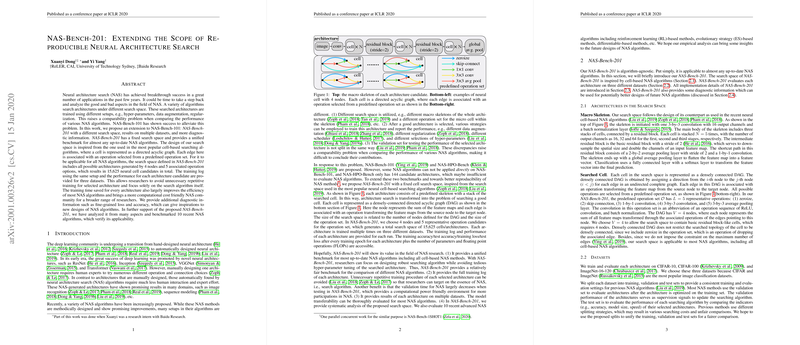An Expert Overview of NAS-Bench-201
The paper "NAS-Bench-201: Extending the Scope of Reproducible Neural Architecture Search" addresses prevalent issues in the field of Neural Architecture Search (NAS) by introducing a comprehensive benchmark, NAS-Bench-201. This benchmark aims to facilitate the reproducibility and comparability of NAS algorithms by providing a fixed search space and extensive performance data across multiple datasets.
Key Contributions
NAS-Bench-201 extends the previous NAS-Bench-101 benchmark by introducing a search space inspired by cell-based searching algorithms. It comprises 15,625 neural cell candidates, achieved through four nodes and five operation choices within a directed acyclic graph. This particular design choice is intended to accommodate a wide range of NAS algorithms, including those based on reinforcement learning (RL), evolutionary strategies (ES), differentiable methods, and hyperparameter optimization (HPO).
Furthermore, the benchmark includes comprehensive training logs and performance metrics for each architecture on three datasets: CIFAR-10, CIFAR-100, and ImageNet-16-120. These resources allow researchers to evaluate architectures without the need to retrain them, improving computational efficiency and fostering a more accessible NAS community.
Performance Metrics and Comparisons
NAS-Bench-201 provides fine-grained performance data such as training/validation/test accuracies, FLOPs, and parameter numbers for each architecture. The dataset supports empirical comparisons across NAS algorithms by leveraging these comprehensive metrics, which also include diagnostic information to inspire new NAS algorithm designs. The provision of full training logs enhances the visibility into each architecture's performance change over time, aiding the evaluation of convergence stability and overfitting tendencies.
Implications and Future Directions
The benchmark's focus on reproducibility and accessibility holds significant promise for advancing NAS research. By providing a unified environment that supports nearly all contemporary NAS methods, NAS-Bench-201 allows researchers to rigorously test and validate different algorithms using a consistent framework.
However, the authors acknowledge the challenge associated with optimizing architecture-specific hyperparameters, posing potential biases in performance assessments. Future developments could consider integrating HPO within the benchmark settings or exploring larger search spaces. Additionally, examining the correlations and rankings of architectures across different datasets offers potential insights into the transferability and generalizability of NAS methodologies.
Conclusion
NAS-Bench-201 represents a substantial contribution to the NAS research field by addressing the comparability problem with a broad-reaching, algorithm-agnostic benchmark. It provides a bridge between efficiency and depth by leveraging an extensive, fixed search space alongside detailed performance metrics. This approach not only refines current NAS practices but also lays the groundwork for future innovation in architecture search algorithms, ensuring they are evaluated under fair and unified conditions.
The paper concludes by welcoming further experimentation on the benchmark, aiming to update results continuously as new algorithms emerge, which underscores its commitment to fostering collaborative and reproducible research in NAS.
